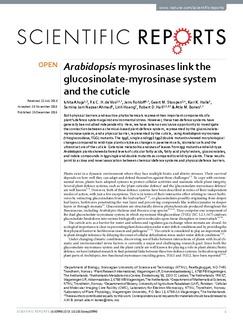| dc.contributor.author | Ahuja, Ishita | |
| dc.contributor.author | de Vos, RCH | |
| dc.contributor.author | Rohloff, Jens | |
| dc.contributor.author | Stoopen, G | |
| dc.contributor.author | Halle, Kari Krizak | |
| dc.contributor.author | Ahmad, SJN | |
| dc.contributor.author | Hoang, Linh | |
| dc.contributor.author | Hall, RD | |
| dc.contributor.author | Bones, Atle M. | |
| dc.date.accessioned | 2019-11-04T08:07:05Z | |
| dc.date.available | 2019-11-04T08:07:05Z | |
| dc.date.created | 2016-12-05T16:44:00Z | |
| dc.date.issued | 2016 | |
| dc.identifier.citation | Scientific Reports. 2016, 6 (38990) | nb_NO |
| dc.identifier.issn | 2045-2322 | |
| dc.identifier.uri | http://hdl.handle.net/11250/2626252 | |
| dc.description.abstract | Both physical barriers and reactive phytochemicals represent two important components of a plant’s defence system against environmental stress. However, these two defence systems have generally been studied independently. Here, we have taken an exclusive opportunity to investigate the connection between a chemical-based plant defence system, represented by the glucosinolate-myrosinase system, and a physical barrier, represented by the cuticle, using Arabidopsis myrosinase (thioglucosidase; TGG) mutants. The tgg2 single and tgg1tgg2 double mutants showed morphological changes compared to wild-type plants visible as changes in pavement cells, stomatal cells and the ultrastructure of the cuticle. Extensive metabolite analyses of leaves from tgg mutants and wild-type Arabidopsis plants showed altered levels of cuticular fatty acids, fatty acid phytyl esters, glucosinolates, and indole compounds in tgg single and double mutants as compared to wild-type plants. These results point to a close and novel association between chemical defence systems and physical defence barriers. | nb_NO |
| dc.description.abstract | Arabidopsis myrosinases link the glucosinolate-myrosinase system and the cuticle. | nb_NO |
| dc.language.iso | eng | nb_NO |
| dc.publisher | Nature Research | nb_NO |
| dc.rights | Navngivelse 4.0 Internasjonal | * |
| dc.rights.uri | http://creativecommons.org/licenses/by/4.0/deed.no | * |
| dc.title | Arabidopsis myrosinases link the glucosinolate-myrosinase system and the cuticle. | nb_NO |
| dc.type | Journal article | nb_NO |
| dc.type | Peer reviewed | nb_NO |
| dc.description.version | publishedVersion | nb_NO |
| dc.source.volume | 6 | nb_NO |
| dc.source.journal | Scientific Reports | nb_NO |
| dc.source.issue | 38990 | nb_NO |
| dc.identifier.doi | 10.1038/srep38990 | |
| dc.identifier.cristin | 1408604 | |
| dc.description.localcode | Open Access CC-BY. This work is licensed under a Creative Commons Attribution 4.0 International License. The images or other third party material in this article are included in the article’s Creative Commons license, unless indicated otherwise in the credit line; if the material is not included under the Creative Commons license, users will need to obtain permission from the license holder to reproduce the material. To view a copy of this license, visit http://creativecommons.org/licenses/by/4.0/ | nb_NO |
| cristin.unitcode | 194,66,10,0 | |
| cristin.unitcode | 194,63,15,0 | |
| cristin.unitcode | 194,65,15,0 | |
| cristin.unitname | Institutt for biologi | |
| cristin.unitname | Institutt for matematiske fag | |
| cristin.unitname | Institutt for klinisk og molekylær medisin | |
| cristin.ispublished | true | |
| cristin.fulltext | original | |
| cristin.qualitycode | 1 | |

